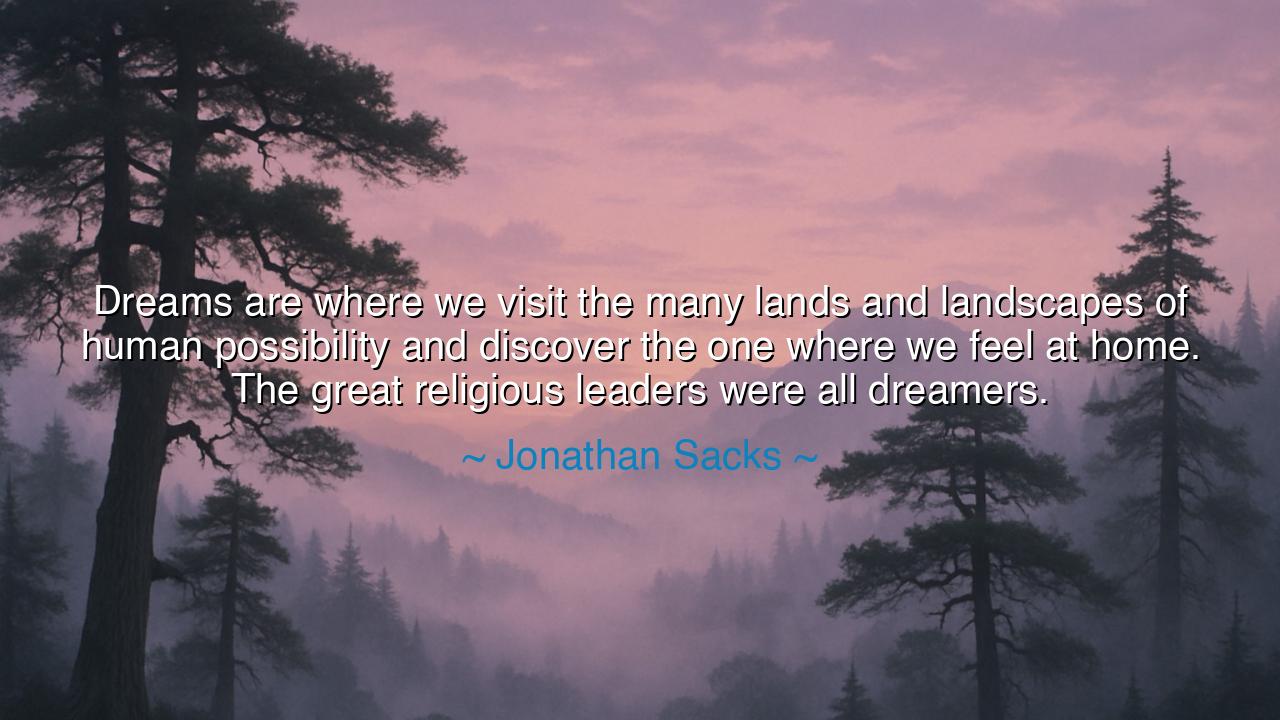
Dreams are where we visit the many lands and landscapes of human
Dreams are where we visit the many lands and landscapes of human possibility and discover the one where we feel at home. The great religious leaders were all dreamers.






“Dreams are where we visit the many lands and landscapes of human possibility and discover the one where we feel at home. The great religious leaders were all dreamers.” Thus spoke Jonathan Sacks, the wise rabbi, philosopher, and voice of compassion in an age of noise. His words move like a gentle river — deep, clear, and filled with ancient light. They remind us that the act of dreaming is not an escape from reality, but a journey toward it. For through dreams — those visions of the possible — humanity has always found its direction. Every faith, every civilization, every act of progress began first as a dream in the mind of one who dared to see beyond the limits of the present.
In this saying, Sacks unveils a sacred truth: that dreams are the maps of the soul. When we dream, we traverse the invisible geographies of the spirit — the mountains of courage, the valleys of fear, the rivers of faith. Through this inner voyage, we learn where we belong, what we believe in, and what we must bring forth into the world. The “lands and landscapes of human possibility” are not physical territories but states of being — compassion, justice, peace, wonder, love. Among them, each soul must find its home — that singular vision that calls to it, that purpose for which it was born.
The second part of Sacks’ wisdom — “The great religious leaders were all dreamers” — reveals the divine lineage of vision. For every prophet, every teacher, every guide who has shaped the moral destiny of humankind began as a dreamer. Abraham dreamed of a covenant where all nations would be blessed. Moses dreamed of freedom for his people and a promised land. Buddha dreamed of awakening beyond suffering. Jesus dreamed of a kingdom of love. Muhammad dreamed of unity under one God. Their dreams were not fantasies, but realities-in-waiting — glimpses of what could be, given courage and faith. Through their dreams, the invisible became visible; the impossible became history.
The origin of this truth lies in the nature of the human spirit itself. Since the dawn of time, humanity has lived by two lights: the light of the eyes and the light of the heart. The eyes show us what is; the heart reveals what might be. The dreamer lives by the second light. To dream, then, is to participate in creation, to see the world not as it is, but as it could be — and to labor toward that vision. The ancient Hebrew prophets called this hazôn — a divine vision that guides a people through darkness. Rabbi Sacks, heir to that prophetic tradition, teaches that every person carries within them a spark of that same visionary flame.
Consider the story of Martin Luther King Jr., who stood before a sea of faces and declared, “I have a dream.” He spoke not of what was, but of what could be — a land where justice would roll down like waters, and righteousness like a mighty stream. His dream, like those of the prophets before him, was not confined to sleep; it was a living dream, one that demanded action, sacrifice, and faith. King’s words remind us that the greatest dreamers are not those who merely imagine, but those who act as if their dreams are already true. His vision became the moral compass for generations — proof that to dream deeply is to shape the destiny of the world.
Yet Rabbi Sacks also offers a gentle challenge: not every dream is worthy, and not every dreamer is wise. The dreamer must discern the difference between self and service, between fantasy and faith. The great religious leaders he names were not dreamers for themselves, but for humanity. Their visions were not for personal gain, but for the betterment of all. True dreaming, then, is an act of moral courage — to imagine a world more just and more compassionate, and to labor toward it with humility and hope.
So, my listener, take this teaching to heart: do not fear your dreams, for they are the whispers of the divine within you. When you close your eyes to rest, let your spirit wander through the many lands of possibility — and when you awaken, bring back from that voyage one truth, one vision, that gives meaning to your life. The greatest journey is not to distant countries, but into the vast landscape of your own heart, where purpose and destiny await.
And remember this, as Rabbi Sacks reminds us: the dream is not an illusion — it is the seed of reality. Every temple, every song, every act of goodness began first as a dream. Therefore, cherish your dreams, but also build them. Let your faith, your work, and your love be the bridge between what you see within and what you leave behind. For in doing so, you will walk among the company of the great dreamers — those who, through their visions, brought light to the world and a home to the human soul.






AAdministratorAdministrator
Welcome, honored guests. Please leave a comment, we will respond soon